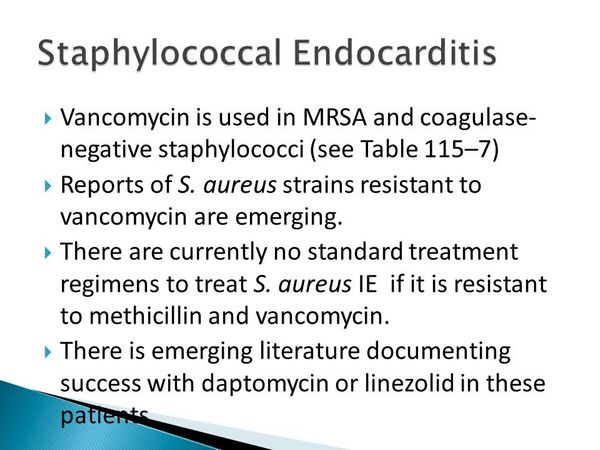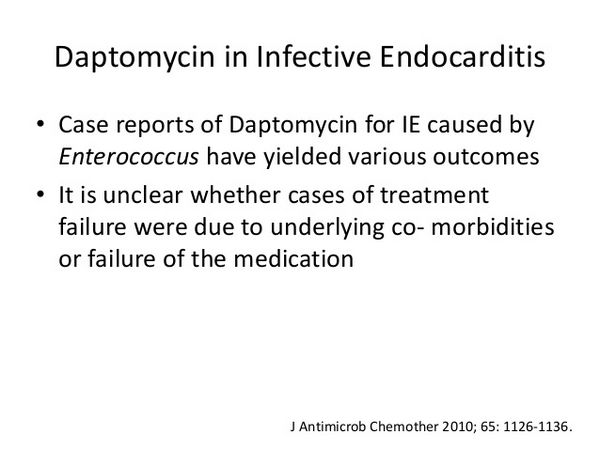- The evaluation of patients treated for Infective endocarditis includes assessment of signs and symptoms, blood cultures, microbiologic tests (e.g., minimum inhibitory concentration, minimum bactericidal concentration, or serum bactericidal titers), serum drug concentrations, and other tests to evaluate organ function.
- Persistence of fever may indicate ineffective antimicrobial therapy, emboli, infections of intravascular catheters, or a drug reaction. In some patients, low-grade fever may persist even with appropriate antimicrobial therapy.
- With effective therapy, blood cultures should be negative within a few days, although microbiological response to vancomycin may be unusually slower.
| TABLE. Treatment of Staphylococcal Endocarditis in the Presence of a Prosthetic Valve or Other Prosthetic Materiala |
| Antibiotic |
Dosage and Route |
Duration (wks) |
Comments |
| Regimen for Methicillin-Resistant Staphylococci |
| Vancomycin hydrochlorideb |
30 mg/kg/24 h intravenous in 2 or 4 equally divided doses, not to exceed 2 g/24 h unless serum levels are monitored |
≥6 |
| With rifampinc |
300 mg orally every 8 h |
≥6 |
Rifampin increases the amount of warfarin sodium required for antithrombotic therapy. |
| And with gentamicin sulfated, e |
1 mg/kg intramuscularly or intravenous every 8 h |
2 |
| Regimen for Methicillin-Susceptible Staphylococci |
| Nafcillin sodium or oxacillin sodium |
2 g intravenous every 4 h |
≥6 |
First-generation cephalosporins or vancomycin should be used in patients allergic to β-lactam. |
| With rifampinc |
300 mg orally every 8 h |
≥6 |
| And with gentamicin sulfated, e |
1 mg/kg intramuscularly or intravenous every 8 h |
2 |
Cephalosporins should be avoided in patients with immediate-type hypersensitivity to penicillin or with methicillin-resistant staphylococci. |
| aDosages recommended are for patients with normal renal function. intravenous = intravenous; intramuscularly = intramuscular. bFor specific dosing adjustment and issues concerning vancomycin, see Table 36-3 footnotes. cRifampin plays a unique role in the eradication of staphylococcal infection involving prosthetic material (see text); combination therapy is essential to prevent emergence of rifampin resistance. dFor specific dosing adjustment and issues concerning gentamicin, see Table 36-3 footnotes. eUse during initial 2 wk. |
|
|

TABLE. Standard Therapy for Endocarditis Due to Enterococcia
|
| Antibiotic |
Dosage and Route |
Duration (wks) |
Comments |
| Aqueous crystalline penicillin G sodium |
18-30 million units/24 h intravenous either continuously or in 6 equally divided doses |
4-6 |
Four-week therapy recommended for patients with symptoms <3 months in duration; 6-wk therapy recommended for patients with symptoms >3 months in duration |
| With gentamicin sulfateb |
1 mg/kg intramuscularly or intravenous every 8 h |
4-6 |
| Ampicillin sodium |
12 g/24 h intravenous either continuously or in six equally divided doses |
4-6 |
| With gentamicin sulfateb |
1 mg/kg intramuscularly or intravenous every 8 h |
4-6 |
| Vancomycin hydrochloridec |
30 mg/kg per 24 h intravenous in two equally divided doses, not to exceed 2 g/24 h unless serum levels are monitored |
4-6 |
Vancomycin therapy is recommended for patients allergic to β- lactams; cephalosporins are not acceptable alternatives for patients allergic to penicillin |
| With gentamicin sulfateb |
1 mg/kg intramuscularly or intravenous every 8 h |
4-6 |
| aAll enterococci causing endocarditis must be tested for antimicrobial susceptibility in order to select optimal therapy (see text). This table is for endocarditis due to gentamicin- or vancomycin-susceptible enterococci, viridans streptococci with a minimum inhibitory concentration of >0.5 mcg/mL, nutritionally variant viridans streptococci, or prosthetic valve endocarditis caused by viridans streptococci or Streptococcus bovis. Antibiotic dosages are for patients with normal renal function. intravenous = intravenous; intramuscularly = intramuscular. bFor specific dosing adjustment and issues concerning gentamicin, footnotes. cFor specific dosing adjustment and issues concerning vancomycin, footnotes. |
|
|

TABLE. Cardiac Conditions Associated with Endocarditis
|
| Endocarditis Prophylaxis Recommended High-risk category Prosthetic cardiac valves, including biprosthetic and homograft valves Previous bacterial endocarditis Complex cyanotic congenital heart disease (e.g., single ventricle states, transposition of the great arteries, tetralogy of Fallot) Surgically constructed systemic pulmonary shunts or conduits Moderate-risk category Most other congenital cardiac malformations (other than above and below) Acquired valvular dysfunction (e.g., rheumatic heart disease) Hypertrophic cardiomyopathy Mitral valve prolapse with valvar regurgitation and/or thickened leaflets Endocarditis Prophylaxis Not Recommended Negligible-risk category (no greater risk than the general population) Isolated secundum atrial septal defect Surgical repair of atrial septal defect, ventricular septal defect, or patent ductus arteriosus (without residua beyond 6 months) Previous coronary artery bypass graft surgery Mitral valve prolapse without valvar regurgitation Physiologic, functional, or innocent heart murmurs Previous Kawasaki disease without valvar dysfunction Previous rheumatic fever without valvar dysfunction Cardiac pacemakers (intravascular and epicardial) and implanted defibrillators |
|
|
| TABLE. Dental Procedures and Endocarditis Prophylaxis |
| Endocarditis Prophylaxis Recommendeda Dental extractions Periodontal procedures including surgery, scaling and root planing, probing, and recall maintenance Dental implant placement and reimplantation of avulsed teeth Endodontic (root canal) instrumentation or surgery only beyond the apex Subgingival placement of antibiotic fibers or strips Initial placement of orthodontic bands but not brackets Intraligamentary local anesthetic injections Prophylactic cleaning of teeth or implants where bleeding is anticipated Endocarditis Prophylaxis Not Recommended Restorative dentistryb (operative and prosthodontic) with or without retraction cordc Local anesthetic injections (nonintraligamentary) Intracanal endodontic treatment; after placement and buildup Placement of rubber dams Postoperative suture removal Placement of removable prosthodontic or orthodontic appliances Taking of oral impressions Fluoride treatments Taking of oral radiographs Orthodontic appliance adjustment Shedding of primary teeth |
| aProphylaxis is recommended for patients with high- and moderate-risk cardiac conditions. bThis includes restoration of decayed teeth (filling cavities) and replacement of missing teeth. cClinical judgment may indicate antibiotic use in selected circumstances that may create significant bleeding. |
|
| TABLE. Other Procedures and Endocarditis Prophylaxis |
| Endocarditis Prophylaxis Recommended Respiratory tract Tonsillectomy and/or adenoidectomy Surgical operations that involve respiratory mucosa Bronchoscopy with a rigid bronchoscope Gastrointestinal tracta Sclerotherapy for esophageal varices Esophageal stricture dilation Endoscopic retrograde cholangiography with biliary obstruction Biliary tract surgery Surgical operations that involve intestinal mucosa Genitourinary tract Prostatic surgery Cystoscopy Urethral dilation Endocarditis Prophylaxis Not Recommended Respiratory tract Endotracheal intubation Bronchoscopy with a flesible bronchoscope, with or without biopsyb Tympanostomy tube insertion Gastrointestinal tract Transesophageal echocardiographyb Endoscopy with or without gastrointestinal biopsyb Genitourinary tract Vaginal hysterectomyb Vaginal deliveryb Cesarean section In uninfected tissue Urethral catheterization Uterine dilation and curettage Therapeutic abortion Sterilization procedures Insertion or removal of intrauterine devices Other Cardiac catheterization, including balloon angioplasty Implanted cardiac pacemakers, implanted defibrillators, and coronary stents Incision or biopsy of surgically scrubbed skin Circumcision |
| aProphylaxis is recommended for high-risk patients; optional for medium-risk patients. bProphylaxis is optional for high-risk patients. |
|
- After the initiation of therapy, blood cultures should be rechecked until they are negative. During the remainder of the therapy, frequent blood culturing is not necessary.
- inhibitory concentrations should be determined for all isolates from blood cultures. MBCs are not routinely recommended.
- Serum bactericidal titers may be useful only when the causative organisms are moderately susceptible to antimicrobials, when less well-established regimens are used, or when response to therapy is suboptimal and dosage escalation is considered.
| TABLE. Prophylactic Regimens for Dental, Oral, Respiratory Tract, or Esophageal Procedures |
| Situation |
Agent |
Regimena |
| Standard general prophylaxis |
Amoxicillin |
Adults: 2 g; children: 50 mg/kg orally 1 h before procedure |
| Unable to take oral medications |
Ampicillin |
Adults: 2 g intramuscularly (intramuscularly) or intravenously (intravenous); children: 50 mg/kg intramuscularly or intravenous within 30 min before procedure |
| Allergic to penicillin |
Clindamycin or Cephalexinb or cefadroxilb or Azithromycin or chlarithromycin |
Adults: 600 mg; children: 20 mg/kg orally 1 h before procedure Adults: 2 g; children: 50 mg/kg orally 1 h before procedure Adults: 500 mg; children: 15 mg/kg orally 1 h before procedure |
| Allergic to penicillin and unable to take oral medications |
Clidamycin or Cefazolinb |
Adults: 600 mg; children: 20 mg/kg intravenous within 30 min before procedure Adults 1 g; children: 25 mg/kg intramuscularly or intravenous within 30 min before procedure |
| aTotal children’s dose should not exceed adult dose. bCephalosporins should not be used in individuals with immediate-type hypersensitivity reaction (urticaria, angioedema, or anaphylaxis) to penicillins. |
|
Serum concentrations of the antimicrobial should generally exceed the minimum bactericidal concentration of the organism, however, in practice this principle is usually not helpful in monitoring patients with endocarditis.



